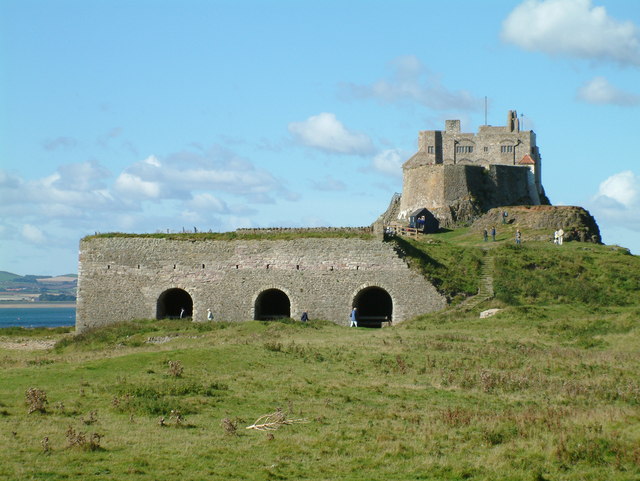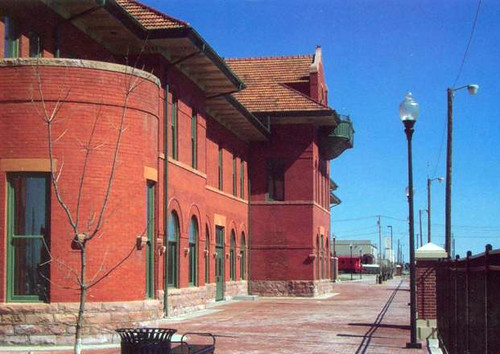
The castle is located in what was once the very volatile border area between England and Scotland. Not only did the English and Scots fight, but the area was frequently attacked by Vikings. The castle was built in 1550, around the time that Lindisfarne Priory went out of use, and stones from the priory were used as building material. It is very small by the usual standards, and was more of a fort. The castle sits on the highest point of the island, a whinstone hill called Beblowe.

Lindisfarne's position in the North Sea made it vulnerable to attack from Scots and Norsemen, and by Tudor times it was clear there was a need for a stronger fortification. This resulted in the creation of the fort on Beblowe Crag between 1570 and 1572 which forms the basis of the present castle.

After Henry VIII suppressed the priory, his troops used the remains as a naval store. In 1542 Henry VIII ordered the Earl of Rutland to fortify the site against possible Scottish invasion. By December 1547, Ralph Cleisbye, Captain of the fort, had guns including; a wheel mounted demi-culverin; 2 brass sakers; a falcon; and another fixed demi-culverin.
 However, Beblowe Crag itself was not fortified until 1549 and Sir Richard Lee saw only a decayed platform and turf rampart there in 1565. Elizabeth I then had work carried out on the fort, strengthening it and providing gun platforms for the new developments in artillery technology. These works in 1570 and 1571 cost £1191.When James I came to power in England, he combined the Scottish and English thrones, and the need for the castle declined. At this time the castle was still garrisoned from Berwick and protected the small Lindisfarne Harbour.
However, Beblowe Crag itself was not fortified until 1549 and Sir Richard Lee saw only a decayed platform and turf rampart there in 1565. Elizabeth I then had work carried out on the fort, strengthening it and providing gun platforms for the new developments in artillery technology. These works in 1570 and 1571 cost £1191.When James I came to power in England, he combined the Scottish and English thrones, and the need for the castle declined. At this time the castle was still garrisoned from Berwick and protected the small Lindisfarne Harbour.In the eighteenth century the castle was occupied briefly by Jacobite rebels, but was quickly recaptured by soldiers from Berwick who imprisoned the rebels; they dug their way out and hid for nine days close to nearby Bamburgh Castle before making good their escape.
In later years the castle was used as a coastguard look-out and became something of a tourist attraction. Charles Rennie Mackintosh made a sketch of the old fort in 1901.
In 1901, it became the property of Edward Hudson, a publishing magnate and the owner of Country Life magazine. He had it refurbished in the Arts and Crafts style by Sir Edwin Lutyens. It is said that Hudson and the architect came across the building while touring Northumberland and climbed over the wall to explore inside.
The walled garden, which had originally been the garrison's vegetable plot, was designed by Lutyens' long-time friend and collaborator, Gertrude Jekyll between 1906 and 1912. It is some distance away from the castle itself. Between 2002 and 2006 it was restored to Jekyll's original planting plan which is now held in the Reef Collection at the University of California, Berkeley. The castle, garden and nearby lime kilns have been in the care of the National Trust since 1944 and are open to visitors.
Lutyens used upturned disused boats (herring busses) as sheds. In 2005, two of the boats were destroyed by arson. They were replaced in 2006 and the third boat has now been renovated by the National Trust. The replacement of the two burned boats by two new boat sheds features on a new DVD Diary of an Island. This shows a fishing boat from Leith being cut in half in a boatyard in Eyemouth and the two "sheds" being transported to the island and lifted into place by crane.
The Spanish architect Enric Miralles used Lutyens' upturned herring busses as an inspiration for his design of the Scottish Parliament Building in Edinburgh

 Military forces on the Santa Fe Trail were reestablished farther north and east at Fort Larned in 1859, but the area around what would become Dodge City remained vacant until after the Civil War. In 1865, as the Indian Wars in the West began heating up, the army constructed Fort Dodge to assist Fort Larned in providing protection on the Santa Fe Trail. Fort Dodge remained in operation until 1882.
Military forces on the Santa Fe Trail were reestablished farther north and east at Fort Larned in 1859, but the area around what would become Dodge City remained vacant until after the Civil War. In 1865, as the Indian Wars in the West began heating up, the army constructed Fort Dodge to assist Fort Larned in providing protection on the Santa Fe Trail. Fort Dodge remained in operation until 1882.
 With the Santa Fe Railroad rapidly approaching from the east, others saw the commercial potential of the region. In 1872, just five miles (8 km) west of Fort Dodge, settlers platted out and founded the town of Dodge City. George M. Hoover established the first bar in a tent to service thirsty soldiers from Fort Dodge.
With the Santa Fe Railroad rapidly approaching from the east, others saw the commercial potential of the region. In 1872, just five miles (8 km) west of Fort Dodge, settlers platted out and founded the town of Dodge City. George M. Hoover established the first bar in a tent to service thirsty soldiers from Fort Dodge. cherilea The railroad arrived in September to find a town ready and waiting for business. The early settlers in Dodge City traded in buffalo bones and hides and provided a civilian community for Fort Dodge. However, with the arrival of the railroad, Dodge City soon became involved in the cattle trade.
cherilea The railroad arrived in September to find a town ready and waiting for business. The early settlers in Dodge City traded in buffalo bones and hides and provided a civilian community for Fort Dodge. However, with the arrival of the railroad, Dodge City soon became involved in the cattle trade.



